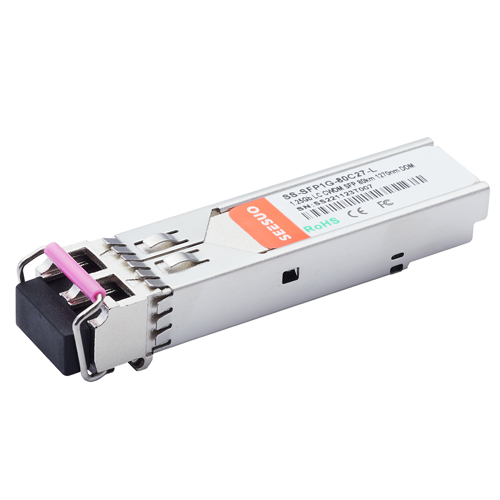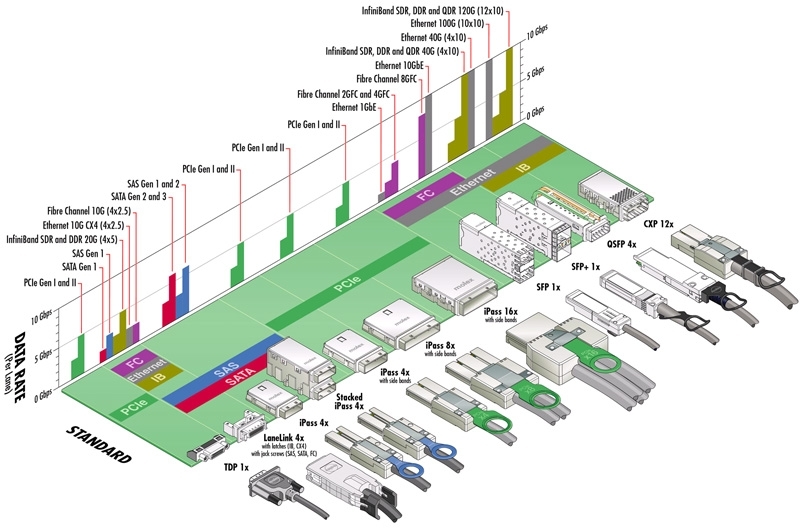- Related articles
- All Cisco CWDM-GBIC-1530's information (List price, Specs, Datasheet PDF, Compatibility ma
- The Difference Between X2 and SFP
- Applicable to 1000BASE-SX Standard Optical Transceiver Models
- What is Mini GBIC?
- All Cisco QSFP-40G-LR4-S’s Information (Overview, Features, Datasheet PDF, Price, Specific
- Optical Transceivers for Cisco SG300-52MP-K9-EU Switch
- Optical Transceivers for Cisco SF500-24-K9-G5 Switch
- Difference between 1000BASE-SX and 1000BASE-LX
- All Cisco ONS-SI-2G-L1's information (List price, Specs, Datasheet PDF, Compatibility matr
- All Cisco XFP10GLR-192SR-L's information (List price, Specs, Datasheet PDF, Compatibility

Definition:
The small form-factor pluggable (SFP) is a compact, hot-pluggable transceiver used for both telecommunication and data communications applications. The form factor and electrical interface are specified by a multi-source agreement (MSA) under the auspices of the SFF Committee. It interfaces a network device motherboard (for a switch, router, media converter or similar device) to a fiber optic or copper networking cable. It is a popular industry format jointly developed and supported by many network component vendors.SFP transceivers are designed to support SONET, gigabit Ethernet, Fiber Channel, and other communications standards. Due to its smaller size, SFP obsolesces the formerly ubiquitous gigabit interface converter (GBIC); the SFP is sometimes referred to as a Mini-GBIC. In fact, no device with this name has ever been defined in the MSAs.
Compatibility
It is possible to design an SFP+ slot that can accept a standard small form-factor pluggable module. Some routing and Ethernet switch equipment allows for the use of a 10 Gbit/s transceiver at lower gigabit ethernet speed, such as with a 1 Gbit/s 1310 nm LX small form-factor pluggable.
Applications
Small form-factor pluggable sockets are found in Ethernet switches, routers, firewalls and network interface cards. Storage interface cards, also called HBAs or Fibre Channel storage switches, also make use of these modules, supporting different speeds such as 2Gb, 4Gb, and 8Gb. Because of their low cost, low profile, and ability to provide a connection to different types of optical fiber, SFP provides such equipment with enhanced flexibility.
Small Form Factor Pluggable module
Small form-factor pluggable modules can also be used to convert electronic signals to optical signals, allowing multi-mode fiber optic cables to be used to connect devices together. The term “High Speed” refers to communication rates of at least 1 Gbps (Gigabit per second); SFP modules used in OPAL -RT’s systems can usually reach 5 Gbps. System expandability: using SFP transceivers, one can exchange data at fast speeds between the FPGAs from two or more OPAL-RT chassis. Communication with third party systems: the protocols described in the following sections can be implemented in 3rd party FPGA cards, making it possible to exchange data at high speed between OPAL-RT products and 3rd party systems.
Conclusion:
Small form-factor pluggable transceivers are expected to perform at data speeds of up to five gigabits per second (5 Gbps), and possibly higher. Because SFP modules can be easily interchanged, electro-optical or fiber optic networks can be upgraded and maintained more conveniently than has been the case with traditional soldered-in modules. Rather than replacing an entire circuit board containing several soldered-in modules, a single module can be removed and replaced for repair or upgrading. This can result in a substantial cost savings, both in maintenance and in upgrading efforts. Several companies have formed a consortium supporting the use of small form-factor pluggable transceivers to meet their common objectives of broad bandwidth, small physical size and mass, and ease of removal and replacement.
SFP transceivers are available with a variety of transmitter and receiver specifications, allowing users to select the appropriate transceiver for each link to provide the required opticalor electrical reachover the available media type (e.g. twisted pairor twinaxialcopper cables, multi-modeor single-modefiber cables). Transceivers are also designated by their transmission speed. SFP modules are commonly available in several different categories.
| Name |
Nominal speed |
Lanes | Standard | Introduced | Backward compatible | PHYinterface | Connector |
|---|---|---|---|---|---|---|---|
| SFP | 100 Mbit/s | 1 | SFFINF-8074i | 2001-05-01 | none | MII | LC, RJ45 |
| SFP | 1 Gbit/s | 1 | SFFINF-8074i | 2001-05-01 | 100 Mbit/s SFP* | SGMII | LC, RJ45 |
| cSFP | 1 Gbit/s | 2 | LC | ||||
| SFP+ | 10 Gbit/s | 1 | SFFSFF-8431 4.1 | 2009-07-06 | SFP | XGMII | LC, RJ45 |
| SFP28 | 25 Gbit/s | 1 | SFFSFF-8402 | 2014-09-13 | SFP, SFP+ | LC | |
| SFP56 | 50 Gbit/s | 1 | SFP, SFP+, SFP28 | LC | |||
| SFP-DD | 100 Gbit/s | 2 | SFP-DD MSA[17] | 2018-01-26 | SFP, SFP+, SFP28, SFP56 | LC | |
| SFP112 | 100 Gbit/s | 1 | 2018-01-26 | SFP, SFP+, SFP28, SFP56 | LC | ||
| SFP-DD112 | 200 Gbit/s | 2 | 2018-01-26 | SFP, SFP+, SFP28, SFP56, SFP-DD, SFP112 | LC | ||
| QSFP types | |||||||
| QSFP | 4 Gbit/s | 4 | SFFINF-8438 | 2006-11-01 | none | GMII | |
| QSFP+ | 40 Gbit/s | 4 | SFFSFF-8436 | 2012-04-01 | none | XGMII | LC, MTP/MPO |
| QSFP28 | 50 Gbit/s | 2 | SFFSFF-8665 | 2014-09-13 | QSFP+ | LC | |
| QSFP28 | 100 Gbit/s | 4 | SFFSFF-8665 | 2014-09-13 | QSFP+ | LC, MTP/MPO-12 | |
| QSFP56 | 200 Gbit/s | 4 | SFFSFF-8665 | 2015-06-29 | QSFP+, QSFP28 | LC, MTP/MPO-12 | |
| QSFP112 | 400 Gbit/s | 4 | SFFSFF-8665 | 2015-06-29 | QSFP+, QSFP28, QSFP56 | LC, MTP/MPO-12 | |
| QSFP-DD | 400 Gbit/s | 8 | SFFINF-8628 | 2016-06-27 | QSFP+, QSFP28,[18]QSFP56 | LC, MTP/MPO-16 | |
Note that the QSFP/QSFP+/QSFP28/QSFP56 are designed to be electrically backward compatible with SFP/SFP+/SFP28 or SFP56 respectively. Using a simple adapter or a special direct attached cable it is possible to connect those interfaces together using just one lane instead of four provided by the QSFP/QSFP+/QSFP28/QSFP56 form factor. The same applies to the QSFP-DD form factor with 8 lanes which can work downgraded to 4/2/1 lanes.
Advantages of Using SFPs
SFPs are widely used today primarily because of three characteristics that define them.
First and foremost, SFPs are small, making them suitable for tight spaces. They are also hot-swappable, an electronic term for components that can be plugged into and removed easily while a computer or device is running. Because of this characteristic, networks can be expanded without redesigning its cable infrastructure.
Lastly, you can choose from several SFP connection options, making the hardware compatible with almost any network. SFPs are also compatible with different communication standards, such as synchronous optical networking (SONET), ethernet, and fiber.
What is the maximum distance between two devices that an SFP port can accommodate?
The maximum distance at which two devices can be connected via an SFP port will vary in practicality depending on the SFP module's data transfer rate, which, in turn, determines what type of cable is used to establish the connection. Take a look at the next section on cables for more information.
Does an SFP port use a copper or fiber optic cable?
SFP ports can accommodate both copper and fiber optic cable connections. The use of a copper or fiber optic cabledepends on the data transfer capabilities of the SFP transceiver.
For example, if your network application requires data transfer rates of up to 1 Gbps at 100 meters or less, you could use a standard Cat 6 Ethernet cable with your SFP. The traditional SFP specification, created by the Small Form Factor Committee, only allows for data transfer rates of up to 1 Gbps, and the Cat 6 sports a 1Gbps transfer rate as well. Basically, these two are a match made in data communications heaven.
If you need faster transfer rates for your application, you’d use an SFP+ or QSFP+ transceiver with a fiber optic cable, which can extend much further than 100 meters without sacrificing performance. The SFP+ and QSFP+ specifications support transfer rates of up to 10 Gbps and 40 Gbps, respectively - a plus for sure. Technically, you could use a higher-category Ethernet cable with an SFP+ transceiver, but you’d be limited to around 30 meters of cabling.
Choose SFP or Advanced SFP+?
According to the transmission speed, the most common SFP module on the market today is the 1Gb, including 1000base-T/TX, 1000base-SX, 1000base-LX/LX10, 1000base-BX10, 1000base-LX/LH, 1000base-EX, and 1000base-ZX.
With the expansion of networks and ever-increasing demand for bandwidth, the 10Gb SFP+ module is becoming more and more popular. 10Gb SFP, also know as SFP+, a newer version with faster speeds of the same form factor. In the SFP+ family, you will primarily find SFP+ SR, SFP+ LR, SFP+ ZR modules for 10 Gigabit ethernet networking.
Please click to check more related concepts:
| Form factor | Communication standard | Speed |
| SFP |
SONET |
10 Gigabit Ethernet |
| GBIC |
Gigabit Ethernet |
|
|
Mini GBIC |























































